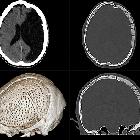methyl methacrylate cranial prosthesis

A methyl methacrylate cranial prosthesis is of heterogeneous density, similar to muscle, and contains locules of gas. The most common cause of a bony defect is trauma, and repair of the defect is called a cranioplasty.
The methyl methacrylate is the monomer form of the final plastic material, typically the supplied preparation consists of separate powdered polymeric and liquid monomeric forms, which are combined by the surgeon, in a two parts powder to one part liquid ratio, to form the moldable polymethylmethacrylate (PMMA) cement. Polymerization is an exothermic process, which may reach 70 °C, and therefore cannot be allowed to occur in vivo due to the clear risk of thermal injury to surrounding soft tissues .
In the usual situation the excised bone can be placed back into the defect (autologous cranioplasty). In some cases the bone is no longer viable, and a synthetic prosthesis must be sought. These may be fashioned in theater as required, cast to a direct mold of the patient’s skull fragment, or rebuilt using data from CT scans of both the patient’s bone defect and the bone fragment.
Gas within a methyl methacrylate cranioplasty is often due to the manufacture process and does not imply infection. Epidural gas or soft-tissue swelling on CT may be suggestive, but clinical assessment is the key to diagnosing infection. Infection occurs in around 4% of prostheses, and is more common when the frontal sinuses are involved.
Other factors which may lead to complications with methyl methacrylate cranioplasties include a large defect, pre-existing infection, and local radiotherapy
Siehe auch:

 Assoziationen und Differentialdiagnosen zu PMMA-Kranioplastik:
Assoziationen und Differentialdiagnosen zu PMMA-Kranioplastik: